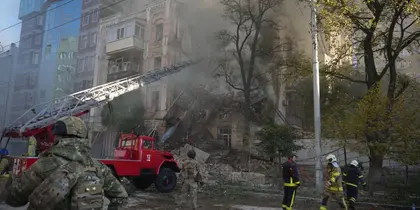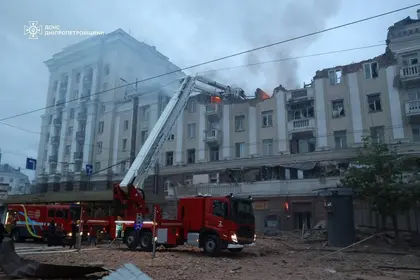The Kremlin on Oct. 17 launched a new wave of Iran-manufactured kamikaze drone attacks against Ukraine. The early morning strikes hit homes and businesses in the capital Kyiv, as well as targets across the country. National power grid infrastructure was also damaged.
Four Shahed-136 drones slammed into Kyiv’s central districts, with one striking an apartment building on a major thoroughfare near the main railway station. The weapon blew out the side of an apartment building and caused a series of fires.
Eyewitnesses on the scene told Kyiv Post of firefighters digging through rubble to reach two residents trapped inside. In a later statement to reporters, Mayor Vitaliy Klitschko said at least three people died in the strike. The trapped pair were successfully freed, he said.
Official Ukrainian websites reported three other drone attacks in Kyiv, with at least one hitting “critical infrastructure.”
Small arms fire was audible to Kyiv Post staff in one central district as one or more drones buzzed with a characteristic lawn mower engine sound towards targets at 8:30 a.m. local time.
Interior Ministry spokesman Anton Herashchenko uploaded a video from the scene of one of the strikes. Three Kyiv police officers were profiled opening up their automatic rifles and pistols on one drone heading towards the Shevchenkivskyi district. Herashchenko claimed that police and other gunfire shot down drones aiming for a nearby power station.
Authorities locked down roads between the city center and the train station to civilian traffic, but pedestrians were able to pass police checkpoints. According to a Kyiv city administration statement, the city’s underground metro system would continue to operate as normal. The national train company Ukrzaliznytsia issued a statement saying that some trains might be late or in rare cases canceled but passengers holding tickets would be allowed on the next train.

Did Peace Between Russia and Ukraine Slip Through Their Fingers in April 2022?
Elsewhere in the city, traffic was relatively light for a Monday morning but moving normally. Around 9 a.m., after the cancellation of air raid warnings, pedestrians returned to the streets.
A Russian combination cruise missile/kamikaze drone strike on Kyiv one week prior killed ten, injured dozens, and damaged power grid infrastructure sufficiently to break electricity supplies to some districts of Kyiv for a few hours. No power grid breaks were reported in the latest round of attacks.
Attacks in other regions
Outside Kyiv, spokesmen for regional defense commands in the Sumy region reported that a cruise missile hit a “critical infrastructure facility.” According to unconfirmed social media postings, the strike damaged power grid infrastructure.
In the eastern city of Kharkiv, authorities reported that Russian Federation (RF) strikes shut down the power grid, while the city metro had stopped working. Since the outset of the war, Kharkiv has been hit almost continuously with shorter-range artillery rockets, and less frequently by longer-range cruise missiles and kamikaze drones. The type of weaponry hitting Kharkiv on Oct. 17 was not immediately reported.
In Ukraine’s south, the Armed Forces of Ukraine (AFU) “Joint Command South,” reported that a Russian X-59 cruise missile was fired from a Su-35 aircraft, hitting infrastructure facilities in the Odesa region. It caused damage but no casualties.
Ukraine’s Army General Staff (AGS) said that AFU units shot down 26 of an estimated 35-40 kamikaze drones launched by Russian forces on Oct. 16 (evening) and Oct. 17 (morning). Ukrainian air force spokesman Yury Ignat told Ukrainska Pravda news magazine that, on average, AFU units had knocked down three out of every four slow-flying Shahed-136 drones launched by the Kremlin.
In the port city Mykolaiv, regional defense commander Vitaly Kim said drones hit industrial infrastructure, causing a temporary fire, as well as a pharmaceutical warehouse. Like Herashchenko, he praised local self-defense units using small arms to shoot down incoming drones or knock them off their target path.
Since the outset of the full-scale invasion in February, the Kremlin has repeatedly claimed that it targets only Ukrainian military units or infrastructure. Another Russian target in Mykolaiv on Monday, Kim said, was the city’s absolutely non-military grain terminals.
“So far in the battle Russia vs. Vegetable Oil [in our terminal] Russia is leading 2-0,” Kim wrote in a Telegram post.
Herashchenko in television comments, called on western nations in general, and Israel in particular, to help Ukraine field air defense weapons to protect itself from the Kremlin’s stated war objective to demolish Ukraine’s power grid and other key infrastructure.
“You [Israel] have a splendid system of air defense that you have developed in 70 years of constant warfare,” Herashchenko said. “To the present day, the government of Israel has given us no assistance – they don’t give us anything and they don’t sell us anything.”
In a tweet on Oct. 16, Israel’s Minister of Diaspora Affairs, Nachman Shai, called on Israel to arm Ukraine, saying: “This morning it was reported that Iran is transferring ballistic missiles to Russia…The time has come for Ukraine to receive military aid as well, just as the U.S. and NATO countries provide.”
“That was a declaration by an individual minister, it was not the position of the (Israeli) government,” Herashchenko said.
You can also highlight the text and press Ctrl + Enter






Comments (0)